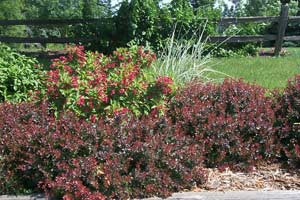Barberry – Pruning, Winter Care and Fertilizing
Barberry; some varieties in this group are rather invasive and should  not be used, check with you designer or the State invasive species list for details.
not be used, check with you designer or the State invasive species list for details.
These shrubs are often used in mass plantings or as a hedge. The same pruning technique can be used if they are planted as a specimen. For these plants, pruning should be done in the early spring, before they leaf out. Shear or prune the outer branch tips to shape and reduce the size of the plant. Repeat this pruning technique throughout the summer, as needed.
If you are forming a hedge, allow light to reach all areas of the hedge by leaving the base of the plants wider than the top. This will help prevent the lower branches from dying. Dense hedges will require “pick pruning” to increase the longevity of the plant. This is done by pruning out small holes in the surface of the hedge to let light reach the interior of the plant and promote inside budding. This interior budding allows you to shear the plants for a longer time without letting the plants get too large. Young shrubs benefit greatly from fertilizing, particularly shrubs that are being used for leaf color rather than for flower development. Granular, liquid or stake type fertilizers can be used. Granular types should be worked into the soil around the plant at a rate of 2 pounds or 2 pints per 100 square feet of planting bed. An alternative way is to drill or punch 6″ deep holes at the drip line of the plant. Poured into these holes should be a total of 1/4 pound of fertilizer per foot of height or spread of the shrub (divided up and poured evenly between all of the holes). These holes should not be filled with more than 1/3 of the fertilizer and then they should be top filled with soil. This method of fertilization should only be done once a year, and is best done in late fall after leaf drop, or in early spring before bud break.
Liquid fertilizers (such as Miracle Gro ) are mixed with water and applied the same as you would water the plant (see product for specific details). This should be done three or four times per year starting in late April and ending in mid July. Stake type fertilizers can be used following the directions on the package. With any of the above techniques a higher nitrogen mix should be used; 21-7-14, 20-10-10, 16-10-9 or similar mixes. Organic fertilizers, like manure, can also be used with good results. This material should be worked into open soil at a rate of one bushel per 6′ shrub or 100 square feet of bed area.
Rabbits can do a great deal of damage to this plant in the winter. The plants can be protected with a fence formed with hardware cloth (looks like chicken wire but with small square holes). To do this, the plants branches should be tied in towards the center, and a circle of hardware cloth can be placed around the outside. The base of the hardware cloth should be buried in the soil or mulch. This protection should be installed in late November and removed in mid April. Red varieties are more susceptible than green to rabbits.
